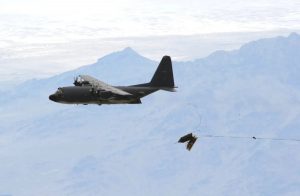The U.S. Air Force has begun to move forward with testing of its “arsenal plane” concept. In January, an MC-130 special operations transport dropped two pallets of air-to-ground munitions off of its cargo ramp in a proof-of-concept demonstration. If the concept proves workable, it could vastly expand the number of aircraft that the Air Force could use to deploy stand-off weaponry, a key priority for cracking China’s A2/AD system of systems. As Joseph Trevithick and Tyler Rogoway detail at The Drive, the Air Force testing thus far has concentrated on air-to-ground munitions, mostly because air-to-air munitions are more complex and may need to be mounted on external pylons. The munitions dropped in the test go by the charming acronym “CLEAVER” (Cargo Launch Expendable Air Vehicles with Extended Range), although the specifics of their range and payload remain uncertain.
As most readers know, the “arsenal ship” involved a large ship that would carry huge numbers of cruise missiles, targeted and guided to their targets by a plethora of space-borne and air-borne sensors. In concept, the arsenal ship was intended to take the load off of aircraft carriers, which could then use their long-range strike wings for alternative missions. Of course, the Navy has yet to pull the trigger on the arsenal ship, although the post-conversion Ohio-class guided-missile submarines (SSGNs) play a somewhat similar role.
The idea behind the arsenal plane is to equip a cargo aircraft with munitions on pallets that can, of their own capability, strike targets at stand-off ranges (beyond the effective range of surface-to-air missiles and most interceptors). Payloads and sensors have grown so sophisticated that the delivery system no longer needs to be. The arsenal plane avoids the elaborate expense and risk of developing a stealthy, penetrating aircraft to deliver munitions against the outer shell of an anti-access/area-denial system of systems. It also allows the Air Force to leverage its already existing airlift assets (which are considerable) for strike missions.
The strategic logic of developing an arsenal plane capability is clear. In low-intensity conflict, the use of such aircraft could take the load off of faster, more combat capable aircraft such as the B-1B, the B-52, or the growing fleet of stealth bombers. In high-intensity conflict, the use of such aircraft (whether from the cargo fleet or the older bomber fleet) could reduce the workload of the USAF’s stealth fleet, while at the same time offering a much larger number of platforms for strikes against outer nodes of sensors and missiles in an A2/AD shell. Some appreciation of this reality undoubtedly comes from an assessment of the threat that Soviet-era bombers (whether flown by China or Russia) continue to pose to U.S. forces, notwithstanding their antiquated airframes. It suggests that the concept of “distributed lethality” increasingly guides thinking in both the U.S. Navy and the U.S. Air Force.

































